Robotic surgery has been around for over twenty years and thus far, over 10 million robotic surgeries have been performed worldwide. For the purpose of statistics, excluding developing countries, 99% of prostate cancer surgeries are performed with the aid of a surgical robot, popularly known as the DaVinci robot. With a population of 1.3 billion, India has 140 robotic surgical units spread across the country. This number is undoubtedly expected to rise owing to newer models hitting international markets as well as the launch of locally manufactured robots. Due to the exponentially growing economy of India, a rising proportion of patients seeking private health insurance, and an increased awareness of the benefits of robotic surgery, patients are opting for the same.
This handbook is an effort to eliminate any myths related to robotic surgery, yet more importantly, to raise awareness regarding what is now considered the future of modern surgery.
In an attempt to simplify and concisely address all surgery-related questions, it has been laid out in a question and answer format. Remember, surgeons should be mindful of the fact that 'no questions are irrelevant', and f ram an anxious patient's perspective, all queries are valid and must be addressed appropriately.
About Us
Sir H. N. Reliance Foundation Hospital and Research Centre is a 345-bed, multi-Speciality tertiary care hospital with following thrust areas: Cardiac Sciences, Gastroenterology & Hepatobiliary Sciences, Liver Transplant, Nephro-Urology, Neuro Sciences, Oncology, Orthopaedics & Spine, and Woman & Child Health. The Hospital has a Medical Mall with progressive diagnostic services, including Laboratories, Radiology & Imaging, and Nuclear Medicine.
This is a technologically-advanced institution designed to international standards and the most stringent criteria in infrastructure, medical care, fire-safety norms, and environmental guidelines. This is because every element that comprises The Hospital’s making, from the premises, to the processes, to its professionals, contributes to the overriding principle: Respect for Life.
Specialities
Technology & Infrastructure
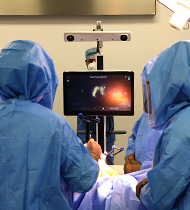
Cori Surgical System
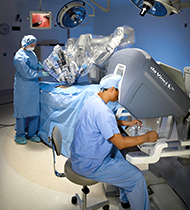
Da Vinci Robotic XI
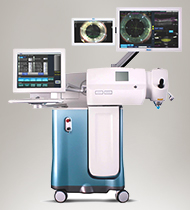
Alcon Lens Laser
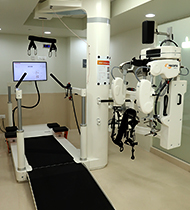
Lokmat - Hocoma Knowledge Platform
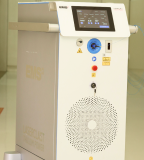
ETHOS
FAQ
What is a Surgical Robot?
A surgical robot is a highly advanced set-up with specialized equipment that allows surgeons to perform complex surgical tasks through tiny incisions using robotic technology.
How does a Surgical Robot look?
A popular myth is that a surgical robot looks like a humanoid, as shown in films. In reality, it comprises of a console that is approximately the size of a refrigerator. The whole robotic set-up also includes two companion machines. The main robotic equipment has four large arms that enter the patient's body through tiny incisions. These arms are connected to the primary console that acts as a control station through which the surgeon operates. There is also a processor (brain) of the robot, also known as the vision cart, which provides the high-definition view.
How does Robotic Surgery benefit a patient?
As mentioned earlier, robotic surgery requires the creation of just a few keyhole openings in the body. As a result of this, even though all the usual steps of an open surgery are carried out, direct trauma to the body is limited. In a nutshell, the major comparative benefits of robotic surgery include; less bleeding, less pain, less scarring, less recovery time and an earlier return to everyday life.
Does this help the surgeon as well?
From a surgeon's perspective, robotic surgery has now become the ideal and most ergonomic method. The surgeon is comfortably positioned in a chair, looking through a console that provides a 3-dimensional magnified field of vision (up to 10 times), enabling visualization of the body tissues with minute detail and precise depth perception. All movements of robotic instruments are extremely refined, highly controlled and skillfully calibrated such that the machine automatically eliminates any minor human tremors.
If the robot is performing the surgery then what is the need of a surgeon?
This question has a very simple answer; a robot does not have its own mind, it cannot think independently and all actions performed by the robot are always controlled manually, whether an industrial or a medical robot. In this case, the commander is the operating surgeon.
At the end of the day, all surgeries are complex and entail a variable amount of risk. Surgeons use their extensive medical knowledge, surgical skills, and vast experience to control the robot in performing the surgery in order to achieve the best possible outcome for the patient.
How is it different from a laparoscopic approach?
Similar to robotic surgery, laparoscopy also involves a minimally invasive approach. However, laparoscopy requires the creation of tiny keyholes in the chest/abdomen/pelvis, and the instruments used to operate inside the patient's body are manoeuvred directly by the operating surgeon.
On the other hand, while the initial steps of creating small incisions remains the same in both kinds of surgeries, the instruments inserted through are far more specialised in robotics. Each instrument has an individual 'wrist' near the tip which provides better flexibility and a much larger range of motion for the surgeon. These long instruments are connected to a surgical robotic unit that is completely under the control of the operating surgeon.
Does robotic surgery take a longer time than conventional open surgery?
On average, robotic and conventional surgeries are almost of the same duration. Robotic surgery being a quick procedure is a commonly held misconception. A suitable analogy to help you better understand this is that of air travel. Regardless of your destination; the time required to check-in, pass security and immigration, reaching the gate, boarding the flight, and finally taking off, almost always remains the same.
Similarly, regardless of the mode of surgery; by the time the patient is taken into the operation theatre, administered anaesthesia, positioned, the robot docked, the procedure performed, the robot undocked, anaesthesia reversed, and finally the patient taken into recovery, the duration of this process somewhat also remains the same.
So far, what specialties are using a surgical robot?
Presently, urology and general surgery are the two specialties conducting the highest number of robotic surgeries. Other specialties employing a robotic approach for some procedures include gynaecological, thoracic, cardiac and ear, nose and throat (ENT) surgeries.
Does robotic surgery entail less complications?
Commonly encountered complications such as pain, bleeding, scarring, and discomfort hold a relatively lower chance of occurring in the case of robotic surgery. Furthermore, the requirement of smaller incisions decreases the likelihood of complications like incisional hernia (protrusion of tissue or organs occurring at the site of a healing surgical scar). However, other complications such as infection and risks associated with anaesthesia have the same probability as that in open or laparoscopic surgery.
What urological surgeries are performed using a surgical robot?
Urology is the one specialty that maximally utilizes the surgical robot at present.
Commonly performed urological robotic procedures include:
- Prostate cancer - Robot Assisted Radical Prostatectomy (RARP)
- Kidney cancer - Robot Assisted Partial Nephrectomy (RAPN - kidney sparing surgery)
- Urinary bladder cancer - Robot Assisted Radical Cystectomy and Urinary Diversion
- Testicular cancer - Robot Assisted Retroperitoneal Lymph Node Dissection (RA- RPLND)
- Penile cancer - Robot Assisted Videoendoscopic Inguinal Lymph Node Dissection (VEIL procedure)
- PUJ obstruction - Robot Assisted Pyeloplasty
Other than those mentioned above, there are several other applications of the surgical robot. Depending upon your condition and surgical requirements, your surgeon will recommend the appropriate procedure for you.
I have heard that the robotic arm is not superior to a human arm. What do you think?
The answer to this question is debatable. One disadvantage of the robotic arm includes the absence of haptic (touch) feedback. On the other hand, the wrist of each robotic instrument rotates a complete 560 degrees compared to the 360 degrees of a human wrist. Undoubtedly, this allows the robotic arm to easily access every nook and corner of the internal body cavity.
Additionally, the surgical robot provides an extra arm to work with which further facilitates easy maneuverability.
Are there any other advantages of robotic surgery I could know?
There are many other hidden advantages of the robot for the surgeon, that enable the surgery to progress in a safe and effective way. To begin with, the surgeon can internally administer and use an ultrasound probe to immediately identify tissue pathology. A special dye can be delivered, and using a built-in infrared camera, blood flow in a specific organ (e.g., kidney) can be determined. Apart from these, the robot allows the surgeon to perform several other customizations as the situation demands.
Are there any disadvantages of robotic surgery?
Currently, the only shortcoming of robotic surgery is the incurring expenditure. Robotic surgery imposes an additional cost of approximately 20-30% than that of a laparoscopic procedure.
Undoubtedly, the surgical robot is a huge financial investment made by hospitals, is not widely available, and thus, maintenance and sustainability are reflected in the surgical cost.
Can the robot malfunction during the surgery?
Despite the robot being a state-of-the-art instrument, there have been reports of rare instances where it has malfunctioned. Generally, just like a computer, a reboot programming immediately solves the issue without compromising the surgical outcome. In an extreme scenario where the robot refuses to operate, the surgeon may undock the robot and convert the procedure into a conventional surgery.
What happens to the robot in case of an electricity (power) breakdown?
All modern hospitals have an electrical back-up source that instantaneously kicks in and restores current in the case of a complete black out. Moreover, the DaVinci robot has a built-in power source that can provide an extra 30 minutes of steady current, should the need arise.
Can any surgeon operate a robot?
The answer is simple, no. Think of it this way, just because someone is able to drive a truck does not imply that they can fly a plane or steer a ship. Similarly, unless your surgeon has undertaken a certain advanced level and duration of accredited robotic training along with preliminary supervised work experience, they are not authorized to operate a surgical robot. Furthermore, in order to be called a proficient robotic surgeon, one must perform at least over a hundred surgeries. In other words, you could say that the number of surgeries performed by your surgeon is an indication of their level of expertise.
What preparation is required before undergoing robotic surgery?
The pre-operative instructions given to patients of robotic surgery and conventional surgery remain the same. These generally include hospitalization a day prior and fasting from six hours prior to the surgery. In select cases, the patient is administered a bowel cleansing treatment for better visualization of the colon. Lastly, body hair shaving is performed as per requirement.
Also, your doctor is likely to refer you to a physiotherapy specialist for pelvic muscle training and exercises. A pre-anaesthetic check-up is another mandate that must be completed before surgery for clearance from the anaesthesiology department. Your urologist might also start you on certain oral medications, as per your condition and specific requirements.
How many days do I need to spend in the hospital after robotic surgery?
On average, considering no post-operative complications and a smooth anaesthetic recovery, your stay within the hospital will be around 4-5 days. Due to certain logistical and transport issues, as well a lack of effective home nursing care within India, this number is higher compared to the minimal 2-3 day stay required in Western countries.
What is the typical recovery period after undergoing a robotic procedure?
Depending on the site and kind of surgery, your time of convalescence will vary. A brief summary of the typical milestones you might encounter while recovering is as follows; firstly, there will be one or two IV cannula lines providing you with fluids for nutrition and hydration. These are usually inserted prior to surgery and remain in situ for at least three to four days post-operatively. You will also have a urinary catheter placed in your urethra that will continuously drain urine. Again, depending upon the type and site of surgery, there may be a drain tube placed inside your pelvis that will drain light colored blood and will be removed in two to three days post-operatively.
On the day of surgery (day 0), you will not be allowed to eat or drink anything from 6 hours prior to the planned time of surgery. All nutrition will be provided in the form of fluids via IV lines.
On the first day post-operatively (day 1 ), you will be allowed sips of water and clear fluids orally, the quantity of which will be increased as the day passes and as you tolerate. You will also be mobilised out of the bed and encouraged to sit on a chair, take a few steps or walk around your bed. For a faster post-anaesthetic recovery, you will also be referred to chest physiotherapy for breathing exercises.
On the second post-operative day (day 2) you can begin a soft diet, and depending upon the regularity of your bowel movements, your diet may be gradually increased. There is a probability that your pelvic drain tube may be removed, provided that the collection is minimal.
On the third post-operative day (day 3), if your recovery has been satisfactory, you may be allowed to go home. However, this decision is completely at the discretion of your treating surgical team and your own conviction of being able to care for yourself independently.
What precautions should I take when I get discharged?
Other than the usual post-operative care instructions like completing your antibiotic regime, rest, hygiene, nutrition, hydration and physiotherapy, there are a few other precautions that deserve some light in the Indian scenario. To begin with, avoid travelling in crowded public transport systems including trains, buses, and rickshaws. The ideal mode of travel would be your own private car or a taxi. It is recommended that you avoid air travel for at least a week following robotic surgery. Your doctor will guide you accordingly for specific organ related convalescence protocols.
How do I choose a suitable and safe hospital and surgeon?
If you encounter a urologist known to specialize in robotic surgery, is accessible, confidently answers your queries, is available for postoperative follow-up care, and most importantly, you feel comfortable with, you've found the one.
You might also be curious to know the type and generation of robotic equipment being utilized. Currently, DaVinci Xi has stood the test of time and is now considered the latest and most advanced 4th generation surgical robot. Other surgical robots include; the Hugo system, CRM, and the locally manufactured Mantra.
Although these are still considered to be safe surgical robots, they are not as exceptional as the DaVinci Xi, and it is important you know what equipment is being used during your surgery.
How do I choose my surgeon?
As a patient, this is a very genuine and real worry. To begin with, it is crucial for you to understand and comprehend the intricacies of your medical condition. That is, clarify whether what you have is cancerous or benign. For convenience, we can classify urologists into three categories; those who exclusively treat urological cancers, those who have a special interest in treating urological cancers, and lastly, those who manage non-cancerous urological conditions.
Most institutes have an accreditation process, upon completion of which, the surgeon is officially designated a robotic surgeon.
Can I find out how many robotic surgeries my surgeon has performed and what their current turnover is?
Of course, you can, you just have to ask your surgeon during your consultation. Surgeons who work in a team may offer better care than those who operate solo. Finally and most importantly, you must feel comfortable and confident with your surgeon in view of their expertise and ability to offer you a comprehensive pre-operative and post-operative follow-up.
Can I ask my surgeon if he has performed enough surgeries?
Again, all you have to do is ask your surgeon during your consultation. If you find the answer provided to be unsatisfactory, non-transparent, or unrealistic, you are entitled to take your time and review your final decision.
If you are worried about seeming impolite or disrespectful, a courteous way to enquire about the same would be to ask how many robotic surgeries the surgeon performs on a weekly basis.
How important is following-up after robotic surgery?
Although robotic surgery comes with the least post-operative complications and a reduced hospital stay, it does not eliminate scheduled follow-ups. This is a very rational concern and you should discuss it with your doctor prior to surgery, if not advised already. Ideally, you would want to meet your operating surgeon during subsequent follow-ups, which is a justifiable expectation. In some instances, due to certain reasons, this follow-up schedule may be handed over to a family physician or possibly the resident/junior doctor from the same team. Although this is not entirely substandard, it can become distressing for the patient. Therefore, it would be wise for you to arrive at an informed decision after considering such factors and exchanging dialogue with your surgeon.
Is it possible to know through online resources whether a particular robotic centre is good for my surgery?
We all know that Google is one of the best search engines out there, however, we must remember that search results are heavily skewed by digital marketing advertisements. There are several factors that can contribute to inaccuracies on Google and other online sources, including: outdated information, promotional marketing campaigns, misinformation, false reviews, bias, and human error. The internet is constantly changing, and it's possible that the information you find on Google may be out of date. Furthermore, promotional videos and other campaigns financing the search engine obscure our ability to form an unbiased, informative, and judicial opinion. It's safe to say that there is no definitive way for you to be certain of the quality and nature of the medical care you are receiving.
Therefore, it is of paramount importance that you develop a comfortable rapport with your treating doctor. This also means that your surgeon should address all your queries without any hesitation throughout your consultation.
How do you know if your surgeon is experienced and safe?
Urologists undergo lengthy, rigorous training after which some choose to super-specialize in a specific type of surgery. Some refine their proficiency in urinary stone removal or LASER surgery, while some may decide to pursue reconstructive, paediatric or laparoscopic (keyhole) surgery. In the same way, urologists who specifically undertake training in robotic surgery will gain the skillset required to deliver a far more experienced and competent patient outcome. You might also be provided the option of speaking with former robotic surgery patients who have provided consent to share their experience. Lastly, it is worth scanning the official qualifications of your operating surgeon.
How much does robotic surgery typically cost?
On average, robotic surgery holds an additional cost of approximately Rs 1.5 lakhs over that of conventional surgery. Undoubtedly, the total cost will vary among different hospitals and also depending upon the class of room chosen by you.
Will health insurance companies cover the cost of my robotic surgery?
In India, four major health insurance providers have extended their cover to include robotic surgery in cases of cancer management, including prostate and kidney cancer. With increasing incidence rates of cancer as well as an increased demand for robotic surgery, health insurance companies are getting on board with the idea of fully bearing the expenditure of robotic surgery.
On the bright side, companies that refuse to cover the cost of robotic surgery cannot reject your claim in totality. They are liable to cover the approximate baseline cost of a conventional or laparoscopic surgery while you bear the supplemental cost of robotic equipment and instruments.
If required, you can also request your doctor to provide you with a letter addressed to your insurance company stating your condition and requirement for a case-based assessment. Sometimes, insurance providers who normally do not cover the cost of robotic surgery extend a complete cover in a few individual cases.
Should I consider open surgery at all in this day and age?
Conventional open surgery has been around for over several hundred years, and currently less than 10% of all surgeries medically qualify for a robotic surgical approach. Having said that, if you are still doubtful of your condition and medical requirements, you should not hesitate to seek a second opinion and reinforce your decision.
How can I be more sure about robotic surgery and also the surgeon who is going to operate on me?
The best way to overcome this worry is to request your operating surgeon to connect you to some of his previously treated patients who have consented to do so. Talking to patients who have experienced the surgeon and surgery first-hand will help alleviate your internal anxiety and help you make a firm decision. You can directly enquire about the procedure, recovery period, surgical outcome and most importantly, your surgeon's approach and commitment towards patient care and a long-term follow-up.
My urologist is quite senior and has treated my father successfully in the past. I would also like to get operated by him. Should I go ahead?
It is very acceptable to go ahead with a surgeon who may have performed a relatively lower number of robotic surgeries thus far. Lesser experience does not necessarily translate to a lack of skill. However, it should be ensured that your surgeon has a highly experienced robotic surgeon around as a mentor throughout your surgery. This is a general protocol followed in order to ensure the standard and quality of patient care until the budding robotic surgeon is deemed fit to perform a complex robotic surgery independently.
My daughter is in the USA. She is insisting that I get operated at a hospital there. What are the pros and cons?
Certainly, America is home to the pioneers of robotic surgery, and as a result of their streamlined medical system, many institutes in the USA are able to treat a large volume of cases in a centralised institute.
Unfortunately, patients who decide to undergo surgery overseas lack the comprehensive post-operative follow-up required after returning to India. Unluckily, in the case of an emergency or complication, addressing and correcting it with limited context becomes a difficult task for a local surgeon. Moreover, the out of pocket cost involved for a non-resident/ citizen to undergo a robotic surgery overseas would be astronomical. Alternatively, you can review and select an esteemed institute that is known to perform a considerable volume of surgeries out of the many, within India.
You might also be interested to know your surgeon's level of training. Although not a hard and fast rule, a surgeon with overseas healthcare experience of even the slightest duration adds some value to their expertise and competence.
My neighbour underwent robotic surgery and faced many complications, he is not happy. That makes me a little afraid of considering robotic surgery for my prostate.
Like any other surgery, robotic assisted surgery is also not completely complication-free. For example, unforeseen circumstances where patients land up in life threatening situations have occurred even during a simple dental procedure. Surgeries, whether minor or major, always come with a risk. While it is unfortunate that your neighbour suffered complications despite opting for a robotic surgery, that does not mean you will face the same experience. There are many patients out there who are extremely happy with their surgical outcome. Essentially, one patient's negative experience should not refrain you from considering a robotic approach for your own surgery.
My surgeon says he has the newest version of a different brand of robot, will that be better than the old DaVinci Robot?
The surgical robot is just a tool utilized by the surgeon to operate with more efficiency and precision. A proficient surgeon will be able to utilize a different model of the surgical robot just like the DaVinci to obtain similar results. Having said that, DaVinci has now launched a 4th generation robot after numerous software and technical upgrades. At large, most robotic surgeons are trained using the DaVinci set-up and therefore, are familiar with the system. For instance, Mercedes Benz ruled the luxury car sector for several decades before other car companies like BMW and Audi refined their technology and have now reached a comparable standard. Similarly, in the years to come, most robotic machines will be expected to reach a paralleled benchmark.
Can I have my benign prostate enlargement (BPH) surgery performed robotically?
Typically, benign prostatic hypertrophy (BPH) is treated by one of two routine methods; transurethral resection of prostate (TURP) or LASER. For very enlarged prostate glands that are deemed unsafe for the above-mentioned methods (for example, glands weighing more than 100-200 grams), a robotic approach can be considered. However, a robotic approach is not the gold standard management for surgical resection of BPH.
Where can I get more information on robotic surgery?
































